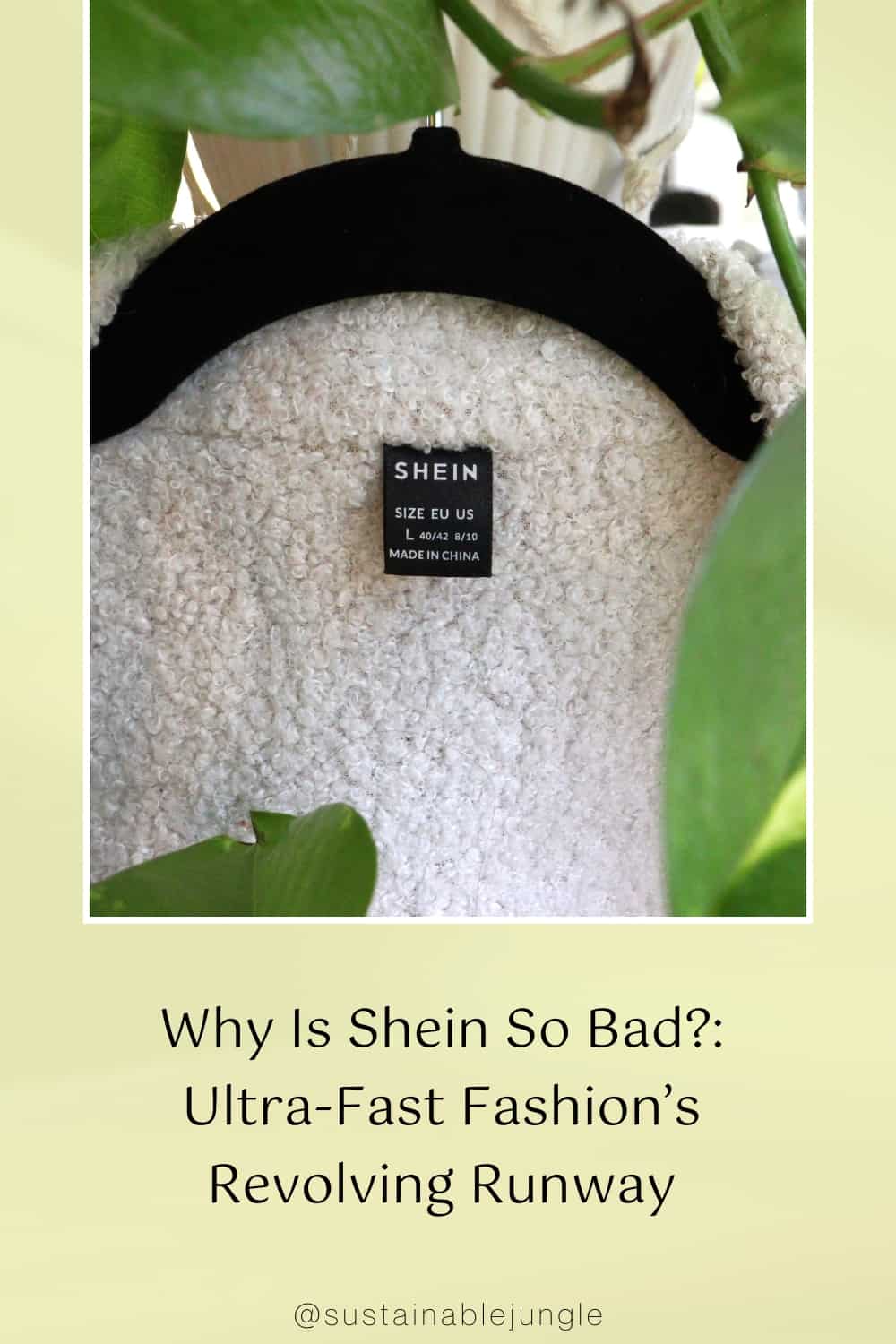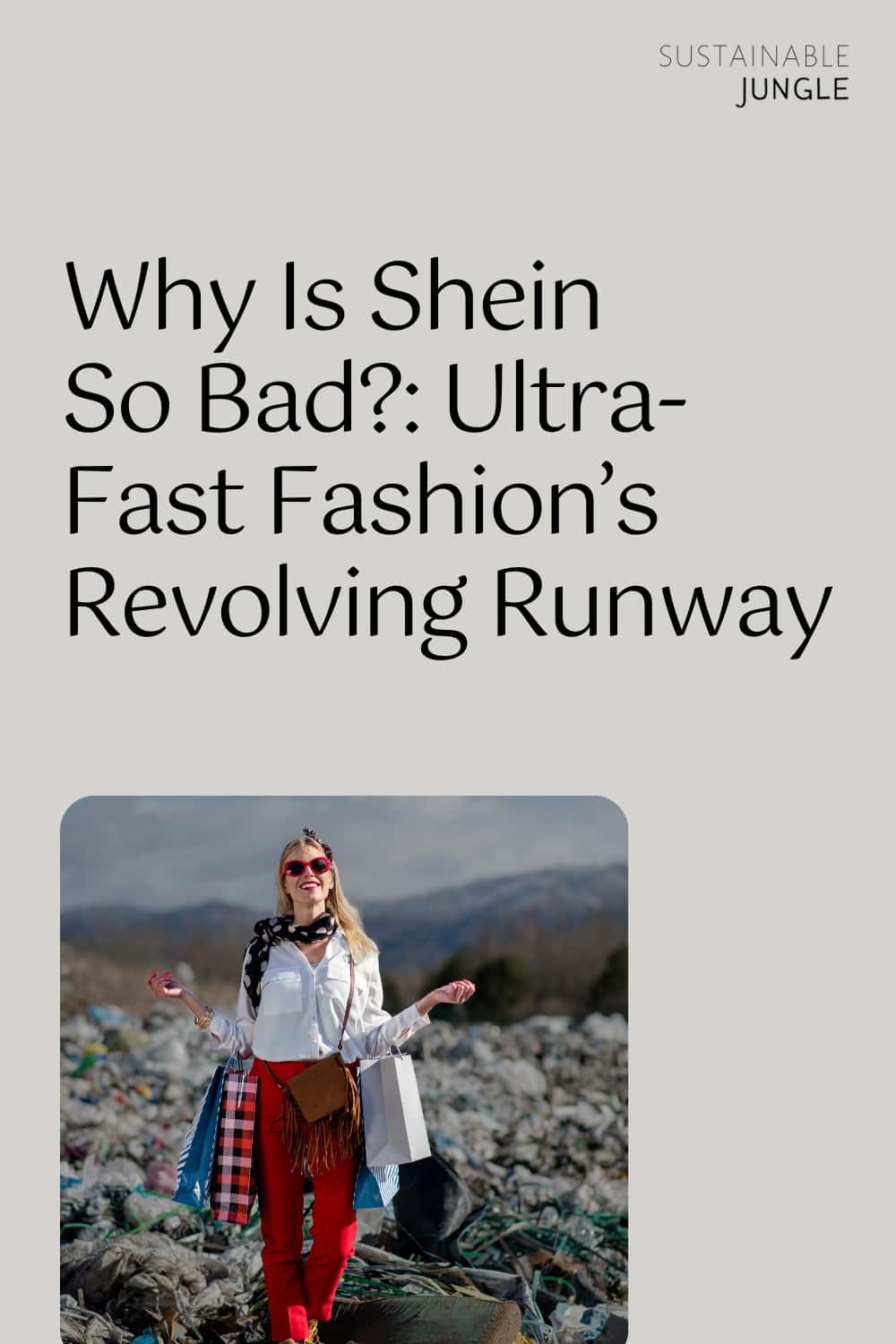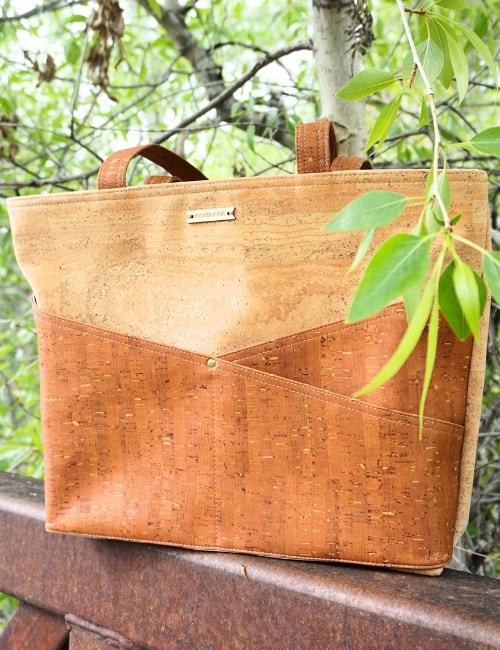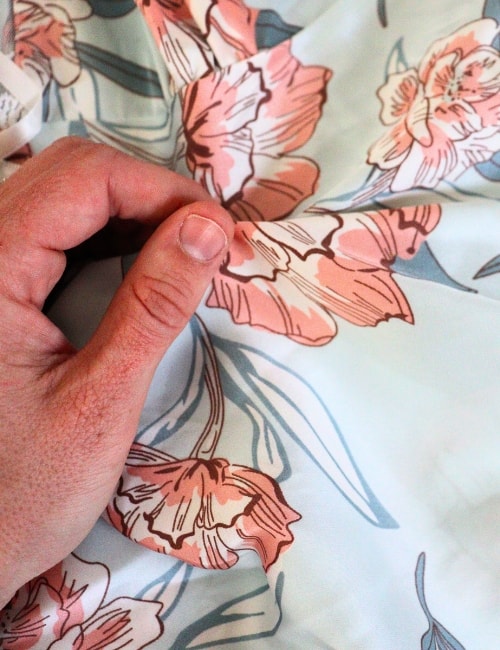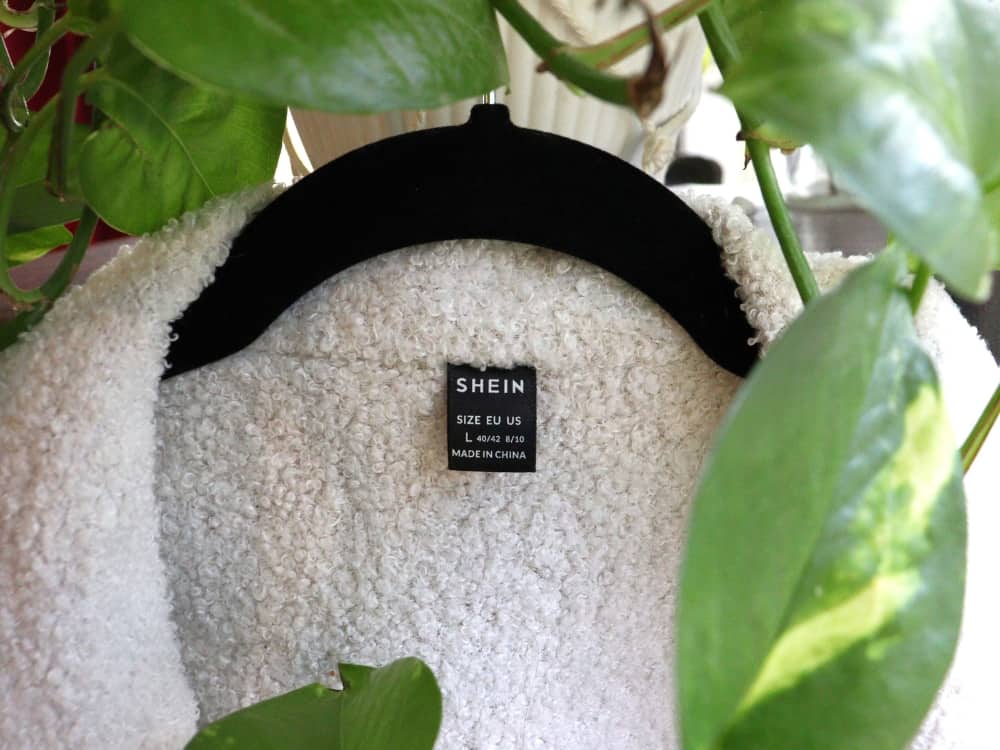
Why Is Shein So Bad?: Ultra-Fast Fashion’s Revolving Runway
Maybe you’ve gotten tricked into looking at their impossibly cheap clothing from an Instagram ad, or maybe you’ve just heard the rumors of the Shein clothing controversy—but exactly why is Shein bad?
Where do we even start?
Their virgin polyester pillaging belches the same CO2 as 180 coal-fired power plants.
They produce over a million trendy clothes styles per year (versus the fast fashion industry average of 25,000.)
Journalists regularly uncover workers toiling in illegal, unsafe, unregulated factories for barely a living wage to sew their bikinis and short-shorts sold at unrealistic and ultra low prices.
Then there’s the looming question mark around slave labor stemming from their cotton supply.
Yet Shein (pronounced she in)—the Chinese fast-fashion behemoth with a history of environmental destruction and labor abuses—continues its insurmountable rise.
With some Gen Z influencers defending Shein with comments like “sustainability is a privilege,” we figured dress-up time doubles as high time to set the record straight.
Sustainability is a human right, and sustainable fashion is a future-proof imperative.
An ultra-fast fashion brand like Shein being permitted to peddle its toxic crop tops with no legislation, taxation, or consequences is the real (albeit dark) privilege, and one that will be significantly curtailed thanks to increased awareness bringing about positive change.
After all, Shein’s very existence relies upon the younger generations bearing the brunt of our climate conundrum. That means inclusive, affordable, ethical, sustainable fashion that benefits people and the planet will become the mainstay.
So, without further ado: Is Shein bad?
We’ll let you be the judge…
1. Who and What Is Shein?
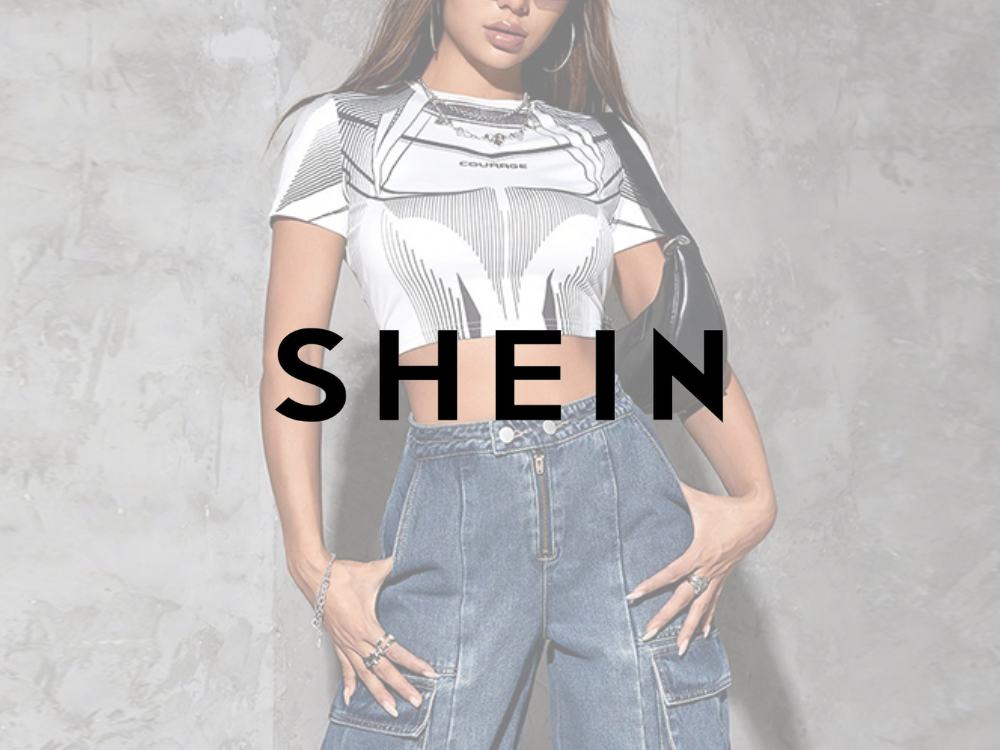
A fashion brand more Googled than Adidas and Nike and that sells more clothes at ridiculously low prices than all fast fashion industry labels combined?
Sounds like Shein.
In only a few years, Shein went from a little-known low-cost online Chinese wedding and women’s wear merchant to a net worth of $100 billion dollars in 2022.
The privately-held and third-largest unicorn company is owned by one very mysterious Chinese-American, Chris Xu, who is more your nerdy Silicon Valley type than a flaunting fashionista. To date, Chris has responded to zero requests for an interview, ever.
It’s this opacity of the Shein business model that is so confounding: as Shein grows exponentially, so do questions about its business practices.
It grabs headlines for its extremely low prices as much as it does for Shein controversies, like stealing the designs of countless designers.
Yet its algorithms keep churning, as it bemuses mostly young women on TikTok and Instagram, turning the shopping experience into a gamified performance and its consumers into both bargain hunters and the hunted (afterall, their forfeited data is Shein’s secret sauce).
The #shein hashtag has nearly 10 billion views. The #sheinhaul hashtag, where customers show off their “hauls” of fresh, cheap polyester follows closely behind.
Shein produces as many as 10,000 new styles—per day.
For comparison, that’s what fast-fashion giant H&M releases in half a year.
Beyond the overwhelming amount of plastic AND controversies the company is embroiled in (which it appears consistently aloof to), Shein is positively bombastic in its approach to rewriting the rulebook of how-to-fast-fashion.
Its business model is so inherently unsustainable and unethical, one lawsuit accuses Shein of being an organized crime ring fuelled by greed, AI, and exploitative human labor that is likely a human rights crisis.
Meanwhile, a quick glance at the company’s website, and you can see they’ve hired a fresh new ESG (environment, social, governance) department to do the dirty work of steam-cleaning all the atrocities Shein committed on its rise to the top of the fashion industry during the global pandemic.
The brand’s jaw-dropping domination is largely thanks to its one-of-a-kind marketing scheme and what it calls its “on-demand” production methodology.
Shein poured millions of dollars into marketing on Facebook, Instagram, and TikTok, and partnerships with celebrities, influencers, and micro-influencers to have 150 million buyers follow in their toxic rayon footsteps.
Every item starts out in “small-batch” production, with Shein’s algorithms determining hot sellers that get picked up for larger orders. Only 6% of Shein’s inventory is sold for 90-plus days.
But just because things are small batches, doesn’t make it sustainable.
Shein has over 6,000 factories in China who operate behind the scenes to churn out their ridiculous amount of bargain-basement threads. If it doesn’t fit?
Shein doesn’t bother with returns; the clothes are too cheap already. A refund is more cost-effective; let the buyer deal with the waste.
2. What Is Ultra-Fast Fashion?

Fast Fashion facts are one thing but is Shein fast fashion?
Not exactly. They go far BEYOND fast fashion.
It’s called the “ultra-fast fashion” model, and it’s pretty much the last thing the world needs at this stage of the climate dilemma.
Shein, along with others like ASOS, Missguided, BooHoo, Romwe (owned by Shein), Fashion Nova, and Cider are considered ultra-fast fashion brands. Their ultra-enhanced “test and repeat” approach takes everything brutal about fast fashion brands and puts them on steroids.
That means faster production pipelines, faster trend cycles, and faster disposal into our brimming landfills. The garments are also ultra plastic, and largely produced from virgin petrochemicals, which are sometimes recalled (like Health Canada did) for harmful materials, only to later shed microplastics and further carbon emissions into waterways and ecosystems.
Beyond the beyond-upsetting impacts on the environment, it’s a shocking new low when it comes to the unethical practices along these ultra-fast fashion supply chains.
Because the brands share zero meaningful information on environmental or workforce wellbeing, all we have to go off are watchdog reports, where journalists go undercover to expose Shein working conditions, like withheld meager pay for small mistakes, seventeen-hour working days, and no days off.
Ultra-fast fashion companies thrive in spite of abusing the planet and people via addictive online “dark patterns” that manipulate consumers into overconsumption.
In turn, buyers share their personal data that gets fed into algorithms to crank out more clothes, more sales, more styles, more “hauls” for social media, more likes, more purchasing, and more waste.
People no longer shop for clothing, they shop for entertainment—and that dopamine rush is exactly what Shein continues to cash in on for private profit.
Zara takes three weeks for a full production cycle—for ultra-fast fashion, it’s one week to as little as three days.
That’s right— from “design” (quotations since the design process is often bold theft), to sourcing, to manufacturing, to shipping, to #sheinhaul video uploaded online—THREE DAYS.
Yet Shein is proud of how it sells clothes via a “real time fashion” methodology, even calling its approach to producing clothing “transformative.”
3. Shein Ethics: Why Is Shein So Bad For Workers?
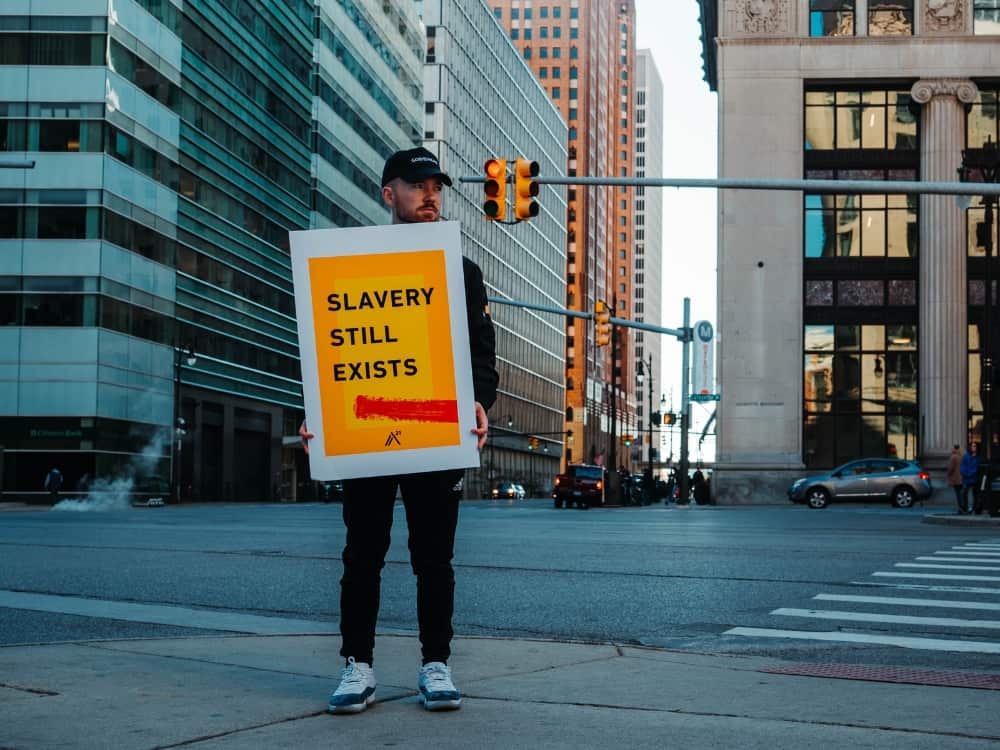
Why do people say Shein is a bad company?
Let’s start with the many Shein ethical issues behind that $10 sweater.
As the fashion leader of Tik-Tok’s “haul” of shame, Shein takes virtually zero responsibility for its social impact, since they only ever apologize upon which another journalist must cover the same story.
Despite their recent “commitments” to more sustainable practices, Shein’s recurring empty promises—only to then get caught again—makes them the Doctor Evil-style villain corporation of some deplorable B-movie.
So, how bad is Shein?
Pretty bad.
While TikTok videos of alleged “help me” messages on garment tags were debunked earlier this year, investigative reports into Shein’s factories raised concerns of the micro-trend cycle’s dangers and the deadly speed at which the industry is accelerating.
Hours way exceeded legal maximums, unfair pay punishments were regular, fire exits and windows were often nonexistent, and garment workers were in a constant state of overwhelm, often living at factories.
Shein has yet to acknowledge or meaningfully address that they purposefully exploit their workers to maximize profit. (One C-level executive tried to convince Time that their profitable rise is thanks to their “real time retail cutting inventory costs”…)
Shein’s Transparency
Shein’s business practices are rife with scandal, and yet they rapidly scale up while remaining a mystery.
Shein isn’t a publicly traded company, so the China-born and Singapore-based fashion brand doesn’t have to disclose sales, revenue, or employment details, and much about its governance, leadership, and ownership remains murky.
But behind the iron veil of the LCD screen that separates the brand online from customers, gross abuses are regularly made.
Since Shein manages to keep such a tight lid on their production, it hasn’t been proven that they use cotton sourced from Xinjiang.
The area, notorious for forced labor camps of the enslaved Uyghur population, is where almost 90% percent of China’s cotton originates. That being said, Bloomberg did a test last year indicating Shein’s cotton products do come from Xinjiang.
Shein’s response?
To neither refute nor take responsibility.
As of writing this, the brand was just asked by US lawmakers to prove its products use no slave labor. Confirmation of this would not only give legal grounds to ban Shein products from the US, but also stop it from becoming a publicly traded company.
In 2022, Shein scored eight out of 150 in Remake’s Accountability Report and in 2021, the brand scored a zero in the organization’s Sustainability Assessment.
Said one Remake representative, “Shein scored zero across all of our assessment categories for its utter lack of transparency in the areas of traceability, wages and wellbeing, commercial practices, raw materials, and environmental justice governance.”
Remake also pointed out that Shein made no supplier list disclosing its approximately 6,000 suppliers available, nor did it disclose wage data or outline a policy for working hours or worker wellbeing.
Beyond that, none of Shein’s supply chain has manufacturing certifications to ensure worker health and safety, living wages or other labor rights.
Shein’s Labor Practices
Two words: slave labor.
While the literal jury’s still out, it’s likely the case (more than 80% of all Chinese cotton sadly comes from there now) and Shein has already lied about dangerous levels of toxic clothing chemicals, systematically ripping off small businesses, and poor working conditions.
How does that all sound for ethical standards?
Between November 2021 and October 2022, three reputable journalistic exposés— here, here, and here—went undercover inside grueling and tedious factories in Guangzhou that supply clothes exclusively to Shein.
With each Shein factory visited, the story was essentially the same: migrant workers desperate for a job would toil for a base salary (often with-held the first month) of about $500USD to make 500 pieces of clothing per day, and beyond that would earn roughly four cents per item.
While overtime was voluntary, Shein workers also probably wouldn’t get paid, might face penalties, or possible termination if staggering daily quotas were unmet.
Work happened around the clock, with a morning, afternoon, and after-dinner shift, usually finishing around 3am only to start again at 8am.
Factories with one day off per month were seen as lucky: most were without a single Sunday free. In Channel 4’s documentary, one anonymous worker had one day off per year (!) to visit her home village on Chinese New Year.
Young women at the factories would wash their hair at lunch breaks and even a small sewing mistake could warrant two thirds deducted of a day’s wages. Sometimes, uneducated workers from rural regions desperate for income were under sixteen years old.
Shein factory working conditions and hours were not only undignified and soul-sucking, but they also violate even Chinese labour law.
When Shein was accused of breaking laws and failing to make the required disclosures on factory conditions, they offered a classically fake-sparkly Shein sheen, saying they “perform regular internal audits”.
“When violations are found, we take further action, which may include termination,” they said.
Meanwhile, this was after they’d already been busted in the first publicized investigation, to which they did their own internal investigation, found 80% required immediate action, and then clearly…
Not enough, Shein. Not enough.
4. Shein Sustainability: Why Is Shein So Bad For The Environment?

Not only is Shein unethical, but like it’s ultra fast counterpart Temu, it’s downright unsustainable, too.
Yet the very un-green Shein machine never stops.
The consequences of their “on-demand” production contributes to the massive ecological footprint of the fast fashion industry—which is already 10% of the world’s total environmental pollution!
The lightspeed that ultra-fast fashion moves at makes the entire endeavor the very definition of unsustainable.
Shein’s production process is based on excessive “small batches”, and their 6000-plus Chinese factories churn clothing items at an unprecedented rate for pocket change prices.
The endless pursuit of volume over craft results in a deluge of bad quality clothes that flood the market. Many of them end up in landfills and incinerators, or get shipped to places like Ghana to deal with it.
A small amount makes it to second hand stores, though the disposable quality and low-cost synthetic fabrics deter a second life.
In March 2023, the European Commission began to alleviate the environmental impact of Shein and other fast fashion labels by setting legislation in motion for how durable and reusable clothes must be and requiring companies to include sustainability details on garment labels.
Shein’s corporate office appears to be readying themselves for scrutiny. With a new ESG team of executives taking on the brand’s environmental, social, and governance grievances, time will tell whether it amounts to greenwashing or a real “evolu-Shein”.
Shein’s Supply Chain
After an unmitigated rise to the top of the fashion industry using any destructive means necessary—exploitative labor, alleged slave labor, informal factories, zero eco-friendly materials, and CO2-spewing air freight—Shein is finally trying to clean up its act.
In their second ever Sustainability Report, the brand launched their evoluSHEIN roadmap to sustainability practices, which comprises nine priorities under three pillars – people, planet, and process – and finally attempts to focus on their critical environmental and labor challenges.
They’ve introduced a Supplier Code of Conduct, a Responsible Sourcing Program, a Chemical and Product Safety Code, and thousands of audits on Shein factories.
Given the merry-go-round of supply chain abuses, apology, and lack of remediation Shein has displayed since it was founded, we’re hopeful the brand finally takes meaningful action toward becoming leaders of an ethical supply chain, along with a sustainable supply chain.
Shein’s Fabrics & Materials
In the past two decades, the number of clothes made every year has doubled. A shocking 150 billion items of clothes are churned out every year now.
In the UK, it’s a truck full of clothing going to the landfill every second.
Almost 70% of all Shein garments are synthetic materials like polyester. Dr Mark Liu, a pioneer of zero waste fashion design, explained in one interview:
“Imagine we’re banning single-use plastics, but then fossil fuel companies are like, ‘OK, I can’t sell plastic here anymore, I’ll just change it to polyester and I can sell it for more money. And I can sell as much as I want because there’s no legislation to stop me.’ We call it fossil fashion.”
In Shein’s latest 2022 sustainability report, they want to become a global leader in deadstock materials rescuing, and will establish a fully circular textile supply chain by 2050, per their 2022 World Circular Textile Day commitment.
They’ve also committed to recycled materials, traceable cotton, and manmade cellulosics, and talk about improving quality and durability, but don’t outline how or how to measure it.
Nor does their report clearly acknowledge Shein’s use of animal products. They do have an Animal Welfare Policy, but its enforcement is unknown—and given their treatment of workers alone, we’d still have to answer NO to those asking, “Is Shein cruelty-free?”.
By 2025, they want the majority of their customer base engaged in circularity. For this, they just released the Beta-version of their SHEIN Exchange platform, a peer-to-peer inventory of secondhand Shein items.
That all sounds nice, but again, considering Shein’s problematic and proven treatment of laborers and their complete failure to uphold any of their other commitments, let’s not hold our breath.
Shein’s Carbon Reduction Commitments
Shein acknowledges in their sustainability report,
“In 2022, production volume increased by 57% and our emissions increased by 52%. The change in our absolute emissions from 6.04 to 9.17 million tonnes CO2e from 2021 to 2022 comes from the strong growth of our business. We are at the beginning of our mitigation journey and began implementing decarbonization programs at the end of fiscal year 2022.”
In other words, in the midst of the ongoing climate crisis, Shein admitted their carbon emissions increased by a whopping 52%.
URGENT decarbonization commitments they have made include:
- Reduction of greenhouse gas emissions (scopes 1, 2 and 3) by 25% by 2030
- Carbon-neutral in scope 2 by 2030
- Source 100% forest-safe viscose and paper-based packaging by 2025
- All packaging from 50% preferred materials by 2030
- Source 50% of SHEIN branded products through the evoluSHEIN by Design initiative by 2030 (their product initiative aimed at accelerating preferred materials and responsible manufacturing processes.)
- A commitment to use 50% recycled plastic for their wasteful Shein product baggies is the only time “shipping” is mentioned, which leads us to assume carbon-intensive air freight is not yet being phased out.
- Queen of the Raw (deadstock) partnership announced
- Committed $15 to the Or Foundation, who clean up textile waste in Ghana
- Partnered with CanopyStyle and Package4Good to stop the use of vital forests in fabric and develop paper-based packaging by 2025.
Again, time will tell if the brand’s need to rehabilitate its beleaguered image spurs actual overhaul of their destructive operations.
5. Shein Controversy, Greenwashing, & Red Flags

So, why do so many people not like Shein?
The amount of controversy that stems from Shein is exhausting. New headlines emerge daily about the routinely bashed brand.
From mishandling customer data and sweatshop labor, to tone deaf product labeling (like selling a Muslim prayer rug as a “Greek mat”), an influencer PR stunt gone wrong, and a serious lawsuit claiming the brand is guilty of organized crime… Shein has a lot to answer for.
Mishandling Customer Data
In 2018, login details for 39 million Shein accounts were stolen. Most affected account holders were not contacted and there was no password reset.
In October 2022, Shein was fined $1.9 million dollars for lying and mismanaging it.
Internet’s “most manipulative website”
Shein’s website was studied to understand its “dark patterns,” including time-limited countdowns, exclusive subscriber discounts, trending stickers and prompts to spend more to get a free gift or delivery.
Research found Shein shoppers were faced with at least eight different instances of dark patterns as they navigate the site to checkout.
Illegal Chemical Use
Greenpeace wrote a damning report stating, “The ultra-fast-fashion brand SHEIN has a business model based on hazardous chemicals and environmental destruction.”
A Canadian broadcaster performed a test in 2021 on a vinyl toddler jacket and purse by Shein, that were found to contain 20x the legal limit for lead in children’s items.
Health Canada recalled them, and the world took note of the regulatory need to reign in Shein.
Tax & Regulatory Evasion
US lawmakers accuse Shein of exploiting a customs loophole to avoid taxes on items under $800 sent to the US. Since the brand has no storefronts, it means their items aren’t subject to the scrutiny that large cargo ship goods are.
This also prevents boycotting Uyghur-produced products.
Cotton From Slave Labor
Is Shein ethically wrong?
While Shein says they don’t use cotton from Uyghur forced labor camps in Xianjing, they’re also notorious liars.
The math simply doesn’t add up to prove they don’t use slave cotton: the volume of cotton garments they produce is astronomical. And 00% of all cotton in China comes from slave labor.
In November 2022, Bloomberg commissioned a lab test which confirmed the sad truth: Xianjing-sourced cotton.
Shein never refuted this and has yet to take formal accountability.
PR Gone Wrong
In a failed PR attempt, the brand sent a handful of US influencers on a paid trip to their Chinese factories in summer 2023. They were taken to a staged “Innovation Center” and fed a very greenwashed, inaccurate picture of Shein.
Influencers were called out for acting as propaganda mouthpieces and later apologized.
Copyright Infringement, Theft, Organized Crime
The list of copyright theft lawsuits against Shein is seemingly never ending.
The brand claims it’s not intentional, and yet they created an algorithm to systematically rip-off independent designers.
As if their supply chain, slave and sweatshop labor, cheap harmful polyester, carbon use, and destructive product end-of-life issues weren’t bad enough, the brand cannot even achieve the first step—design—with integrity.
They’re currently facing a court case that accuses them of organized crime to steal designs.
Forever21 Collaboration
At the time of researching this article, Shein’s latest move is sustainable fashion’s greatest fear.
The brand, whose US pop up store tour was a success, snatched up a partnership with the beleaguered 2000s teen dream (and eco nightmare) Forever21.
Call it the year’s most deplorable partnership of cheap plastic, with Forever21 sold on Shein’s site, and Shein coming to Forever21 stores near you.
6. Any Positive News About Shein?
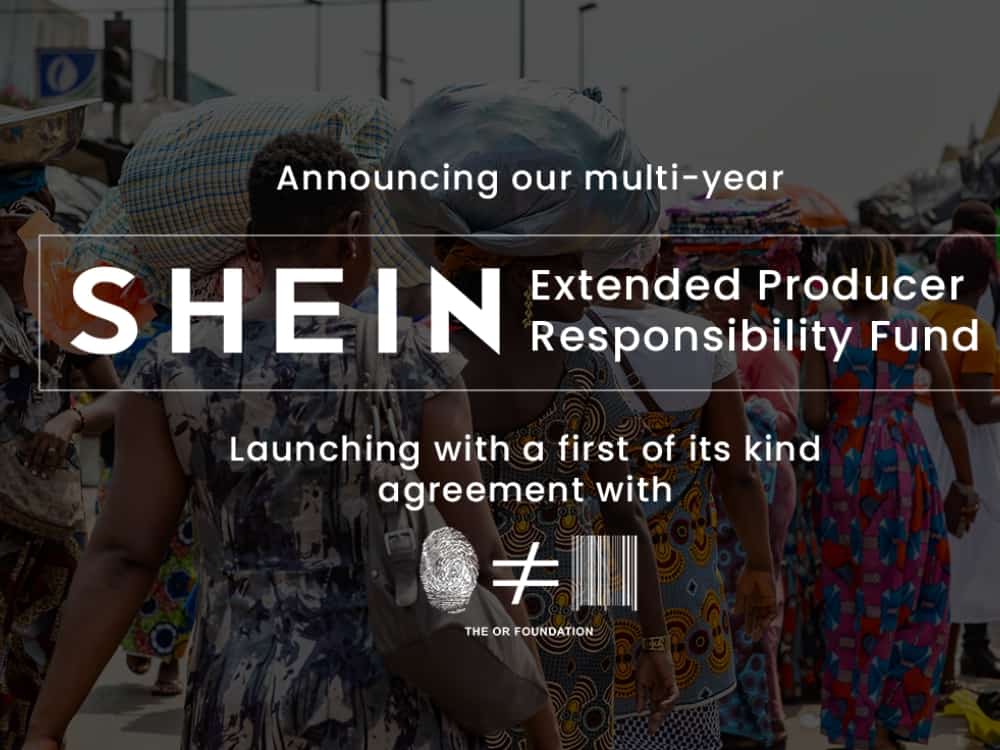
It’s not all doom and gloom with the Shein machine, who now wants to become a trendsetting, revolutionary sustainable fashion company.
Regardless of their true motives, the brand has made recent strides to improve its sustainable practices.
- To tackle fashion waste, Shein set up an Extended Producer Responsibility (EPR) Fund, to which the company will dedicate $50 million over the next five years.
- As part of it, Shein donated $15 million to the Or Foundation, who help manage endless textile waste streams in Ghana.
- Their newfound partnership with Queen of the Raw could revolutionize deadstock materials being repurposed, if the brand really does manufacture 50% of its inventory from it.
- One study showed 4 out of ten Shein shoppers prefer buying sustainable fashion. This indicates the momentum for sustainability is growing, and there is hope for us all.
Still, is Shein OK to buy from?
Not unless they make a serious turnaround—and given their past and current abuses, we’re more inclined to say that Shein is irredeemable.
7. Sustainable Alternatives To Shein
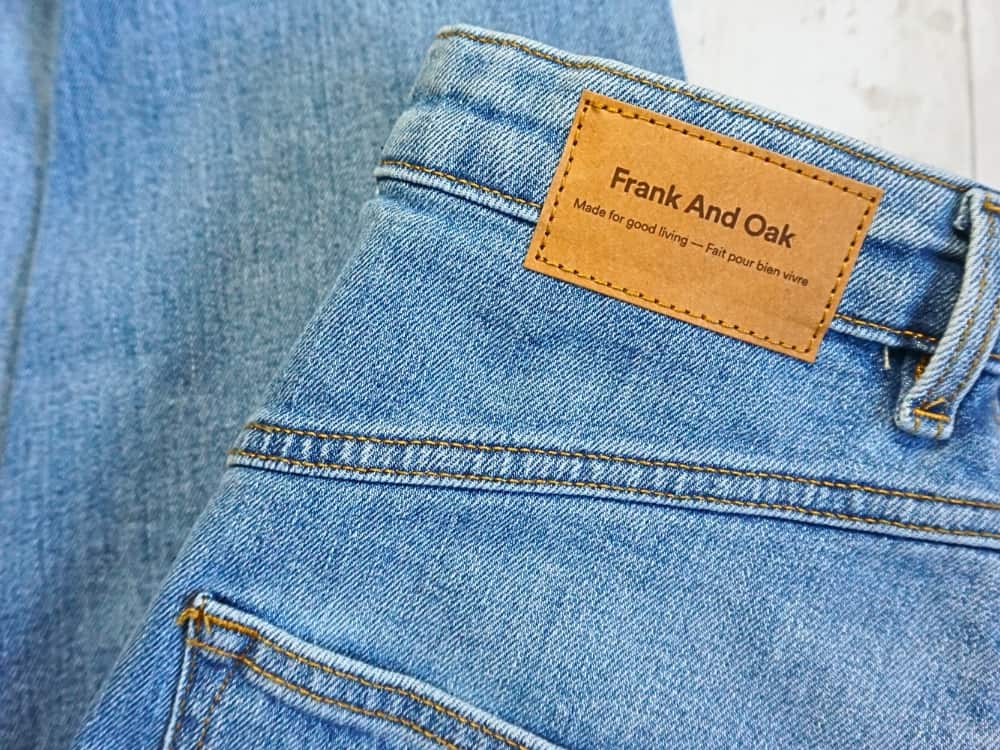
Shopping second hand (online or IRL) is one of the more sustainable alternatives to ultra-fast fashion brands.
1,452 participants of Remake’s ‘No New Clothes’ challenge saved 300,564 kgs of CO2 and 13,213 kg of waste.
Apply that to Shein’s 142 million customers and the potential for positive impact is tremendous!
Budget shouldn’t be an impediment, since thrifting is some of the most affordable clothing available—that’s also higher quality than Shein’s, used or not.
We’re not saying you have to stop buying new altogether, but we are saying you should shop from slow fashion brands working to halt Shein insane production pace.
Second to perusing pre-loved, we’ve gathered our favorite eco-friendly clothing brands to shop from instead—because individual action can create collective change.
Did you know we Have a Newsletter?
We cover the latest in sustainable living, fashion, zero waste, beauty, travel, finance and more…
Final Thoughts On Is Shein Ethical?
To recap: is it bad to buy Shein?
As one Tweet put it, “why tf are people doing shein hauls, like haven’t you shein haul this global warming going on?”
Ultra-fast fashion is anything but cheap—somewhere and someone is paying the true price.
Yet, the current lack of legislation paired with strategic “loopholes” to grow infinitely simply cannot upon a finite planet.
Slow fashion means to fulfill our collective responsibility to protect our planet—and the wellbeing of our species—for future generations, while celebrating the expressive magic and utilitarian comforts that fashion can offer.
Shein as the fashion industry prototype is untenable and a perfect example of why we do what we do here at Sustainable Jungle spreading the word about better slow fashion alternatives.
So please, help us in a mission to make fashion a force for good.
Because things may fall in and out of style, but sustainability ensures symbiosis and preservation for generations to come—and that is our right.
The next time you catch a colleague falling into “dark patterns” with online haul upon haul, or overhear someone asking, “Is Shein an ethical company?”, or maybe, “is dolls kill fast fashion“, share this article.
Pin these:
